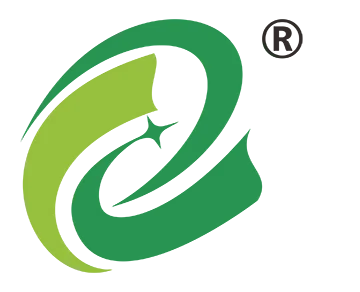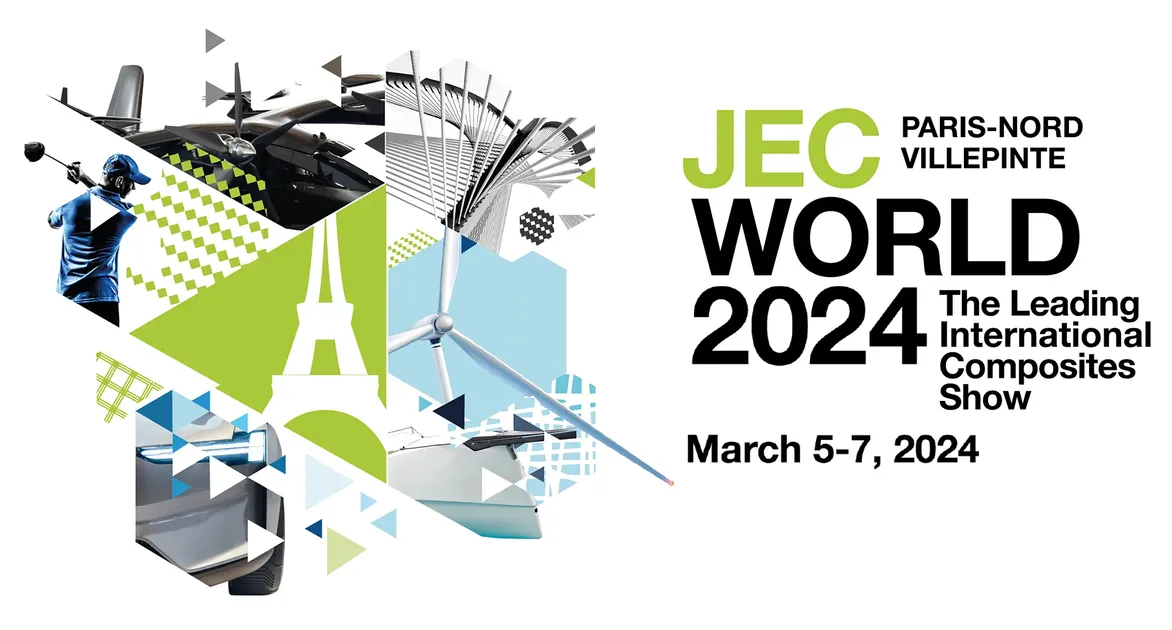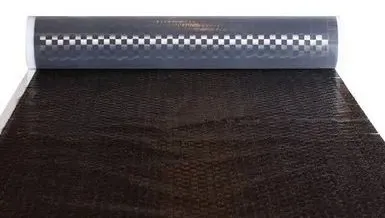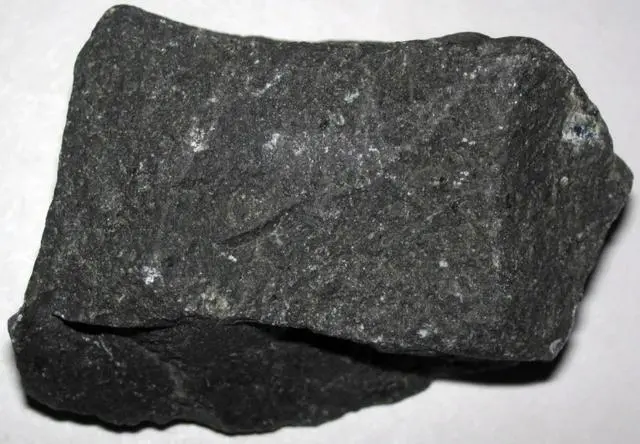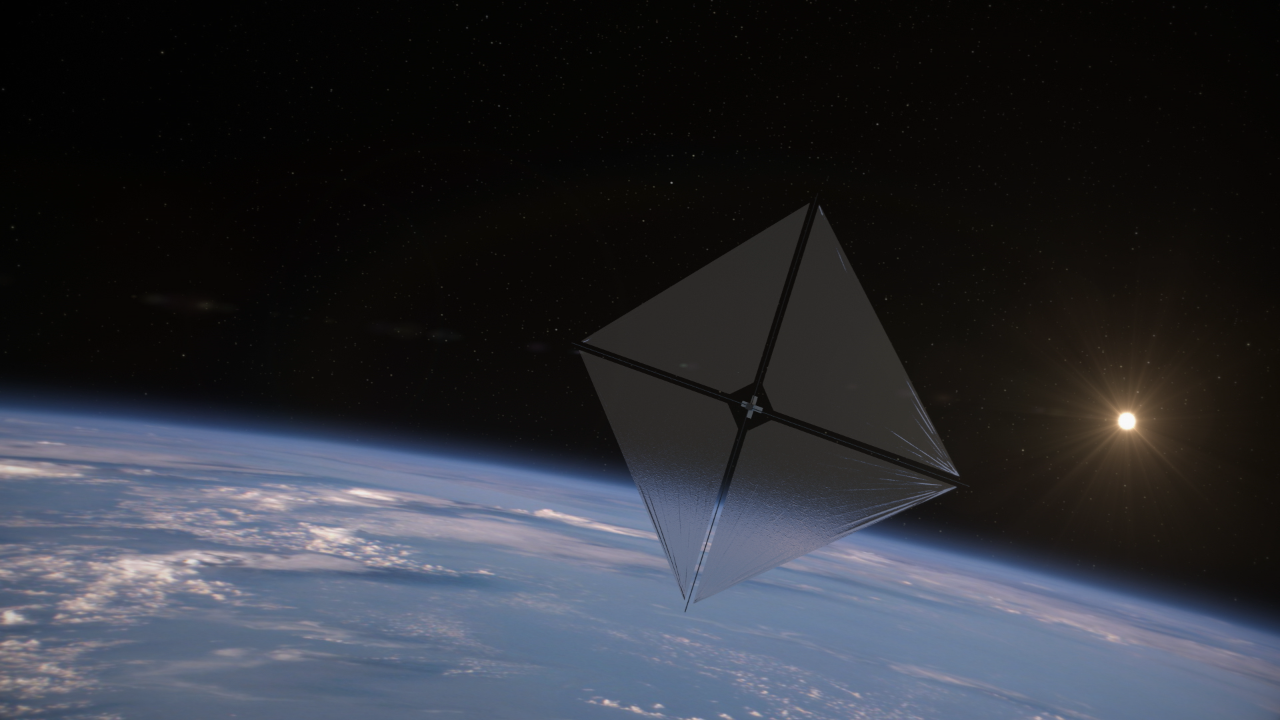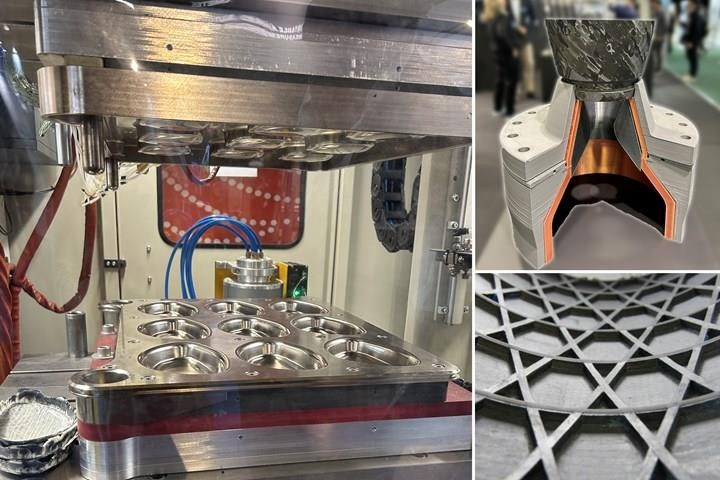
Highlights of JEC World 2024 (left, clockwise): Unwind3D inductive heating Spidui forming pool for thermoplastic composites; DLR’s C/SiC ceramic matrix composite (CMC) rocket nozzle extension and CIRA’s composite anisotropic grid structure prepared using novel dry fiber and resin infusion parallel winding.
JEC World 2024 (March 5-7, Paris, France) is renowned for showcasing numerous compelling composite parts and advancements. Sustainability remains a common theme, with numerous hydrogen storage tanks featured in the exhibition. Here, we share some highlights from the exhibition.
Key themes include:
– TPC development: Deep-drawn RCF parts, CF/PEKK aerospace demonstrators
– AAMMC Technology Center for large TPC aerospace structures
– AI-assisted tool-less TPC welding
– C/C-SiC in rocket nozzles, piston rings, and optical benches
– The largest infiltrated C/SiC component
– Customized CMC in the UK
– SiC fibers and CMC components in Germany
– Inductive heating industrialization, multiple composite solutions
TPC Development: Deep-drawn RCF parts, CF/PEKK aerospace demonstrator
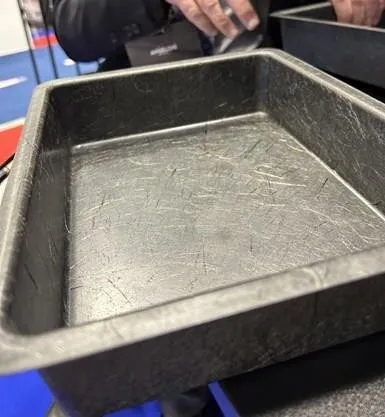
ATC’s deep-drawn demonstration parts are made without preforms, directly stamping rCF nonwoven mats into KyronTEX thermoplastic sheets with PPS or PEI matrices. ATC Manufacturing (Post Falls, Idaho, USA) showcased deep-drawn thermoplastic composite (TPC) parts made using KyronTEX materials provided by Mitsubishi Chemical Group (MCG, Tokyo, Japan). These materials combine recycled carbon fiber (rCF) with polyphenylene sulfide (PPS) or polyetherimide (PEI) polymers in the form of mat products, targeting secondary structures inside aircraft. The lofted nonwoven rCF material uses fibers of 1-2 inches in length and is supplied in 250 grams per square meter and 500 grams per square meter face weights. David Leach, ATC’s Business Development Director, explained, “We want to form deep-drawn shapes quickly and economically in one step, rather than consolidating a preform first and then stamping it.” “We’ve developed a method to directly stamp TPC mat material, which can produce high-quality parts in a 5-minute cycle time. We have a long history of TPC part forming and understand how parts made from fabrics and unidirectional (UD) tapes can wrinkle in corners. But this mat works very well. We’ve also developed a second variant with Mitsubishi, combining fabric with the rCF mat to increase stiffness.”
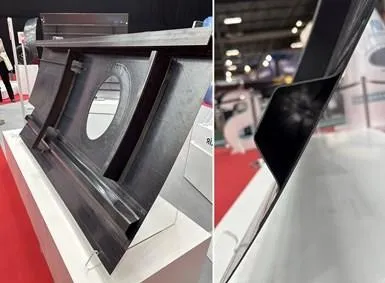
ATC Manufacturing is also a key partner in the HAICoPAS project TPC fuselage panel demonstrator, which is showcased at the Mobility Planet at JECWorld 2024. The demonstrator is made using HexPly thermoplastic prepreg tape composed of Hexcel AS7 and IM carbon fibers with Arkema Kepstan polyetherketoneketone (PEKK) polymer (CF/PEKK). The components are produced by different partners and processes:
– Ω stringers using continuous compression molding (CCM)
– I- and T-shaped stiffeners using pullforming by Hutchinson
– Z-shaped frames using stamping by Daher
– Fuselage skin and “C-shaped” frames manufactured using the out-of-autoclave (OOA) process by Hexcel
The ISW (Induction Soldering Welding) developed by Arkema company connects these welds. Other alliance partners include Coriolis Composites, Ingecal, Pinette Emidecau Industries, and CNRS Laboratories. The goal is to demonstrate that composite parts can replace metal in aircraft structures, achieving high productivity and cost competitiveness. The project is also able to characterize CF/PEKK materials.
Rich said, “We have manufactured Omega stringers using six layers of Hexcel IM7/PEKK 190 grade material in a flat CCM (Compression Molding Machine). “Usually, you would make it in a biaxial CCM, which is easier. But we have a method to make Omega shapes in a planar CCM, which reduces the cost and complexity of tools and equipment.”
Advanced Composite Manufacturing Technology Center for Large TPC Aerospace Structures
ATC Manufacturing Company is also a key partner of the American Aerospace Materials Manufacturing Center (AAMMC), which will drive the supply base of large TPC aerospace structures and materials to achieve technology readiness levels (TRL) 6-9. It will include an advanced composite material testbed and technology maturation facility located in the Boeing Triumph Building in Spokane, Washington, owned by Lakeside Company.
AAMMC Technology Center for Large TPC Aerospace Structures and Materials Goals (top), Regional Development Map (middle), and Consortium Partners (bottom)
Maria Lusardi, Marketing Director of Lakeside Company, explained, “We believe that faster industrialization of thermoplastics and advanced composites in the United States is crucial for supply chain competitiveness and our domestic manufacturing base. In addition, these materials provide faster cycle times for producing lightweight, high-strength parts. Without significantly reducing the cycle time and piece cost of composite parts, the industry cannot meet the current expected demand for aircraft or achieve net-zero emission goals.” The AAMMC alliance includes companies and educational institutions from Spokane to Coeur d’Alene, Idaho. It aims to develop disruptive high-speed production solutions for the next generation of composite aerospace structures and accelerate the achievement of NASA and the aviation industry’s net-zero emission goals by 2050
. As one of the 31 technology centers established in October 2023, AAMMC competed for $500 million from the federal CHIPS and Science Act and submitted a second-phase proposal in February 2024 requesting $72 million from EDA, plus $8 million in industry commitments, for a total of $80 million in funding for the first five years, followed by self-sufficiency. Lusardi said, “A significant portion of the funding request is for equipment, including AFP (Automated Fiber Placement) for producing TPC preforms, large stamping presses, as well as machining and non-destructive testing equipment. The winner of the second-phase funding will be announced in the summer of 2024, and the funds will be disbursed in the fall. Our goal is to install and commission all equipment in two years. At the same time, we will start increasing workforce training. For example, this will include apprenticeships in machining focused on composites. All consortium members have committed to providing cash, workforce training, equipment, staff time, machine time at their facilities, or other significant contributions that benefit center members. We believe that the Northwest Technology Center has extensive talent and significant impact on the entire region and the entire aviation industry.”
AI-assisted Tool-free TPC Welding
The Institute for Structure and Design at the German Aerospace Center (DLR) in Stuttgart and Augsburg showed a video of their development in using dual robots for tool-free AFP and fixture-free welding of TPC structures. Similar to the technology demonstrated by General Atomics and Mikrosam in 2019, the multi-robot unit is used to reduce the cost and time of fixtures and molds and increase design flexibility for composite aerospace structures. The improvement in robot platform accuracy utilizes AI-assisted trajectory geometric correction as well as modeling, parameter identification, and real-time compensation of robot structural deformation during AFP and ultrasonic welding to produce complex curved composite structures.
This development is also international, a collaboration between the National Research Council of Canada (NRC-AMTC, Montreal) and the Lightweight Production Technology Center (ZLP, Augsburg) of the German Aerospace Center. ZLP provides expertise in aircraft structural components, TPC production processes, and automated offline robot programming, while NRC provides geometric and elastic calibration technology as well as real-time path compensation modules for the multi-robot system.
C/C-SiC in Rocket Nozzles, Piston Rings, and Optical Workbenches
DLR presented three different ceramic matrix composite (CMC) projects:
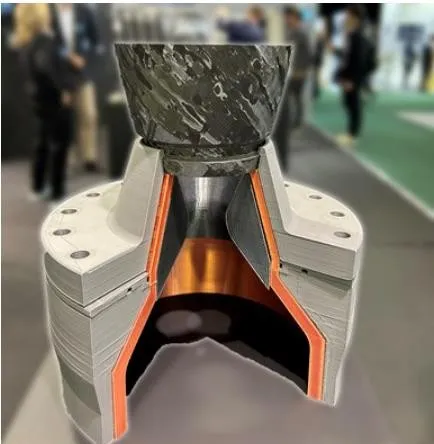
The ATHEAt project (2022-2025) aims to improve the reliability of critical high-temperature components for reusable launch vehicles and future space transportation systems. Components will be demonstrated through ground and flight tests. Utilizing carbon fiber and carbon silicon carbide matrix (C/C-SiC), rocket nozzle extensions were designed and produced for the German Aerospace Center’s Viserion+ hybrid engine. The goal is to improve nozzle efficiency by significantly reducing wear and component weight, enabling reuse. Sounding rocket flight tests, which have already been proven in ground tests, are being prepared as part of the qualification process.
The KoRSICa project (2018-2022) developed C/C-SiC piston rings to replace metal rings, enabling higher temperatures and more efficient engine power generation. Monolithic ceramics can withstand very high temperatures but are too brittle for monolithic piston rings. Fiber-reinforced CMC meets mechanical load and elasticity requirements, and the amorphous carbon in the matrix increases self-lubrication, preventing the risk of dry running, piston seizure, and engine damage. These rings are undergoing testing in local energy projects.
The Technology Development Element (TDE) project “C/C-SiC Optical Bench Development” (2022-2024) is a collaboration between the European Space Agency (ESA) and Thales Alenia Space France (TAS-F). The goal is to develop an ultra-stable optical bench using CMC for satellites, achieving high stiffness and near-zero thermal expansion. A universal demonstrator (600x600x60 mm) was manufactured, including an interface concept based on in-situ bonded C/C-SiC inserts to avoid minimal local deformations that metal inserts might cause. The demonstrator will be tested by TAS-F.
Largest melt-infiltrated C/SiC component
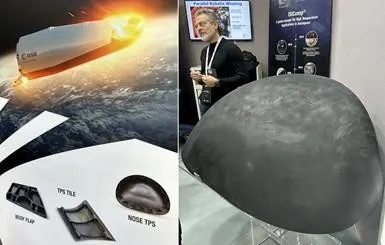
Centro Italiano Ricerche Aerospaziali (CIRA) in Capua, Italy, showcased the CMC nosecone for the Space Rider, a reusable non-folding robotic laboratory developed by ESA for commercial and institutional customers. Roughly the size of two minivans, Space Rider is an end-to-end transportation tool designed to provide affordable, independent access to space. The Space Rider will be launched, stay in orbit for 1-2 months to complete scientific and commercial missions, and then return to Earth.
According to a US technology expert, the nosecone developed by CIRA is one of the largest melt-infiltrated CMC structures ever produced. The structure utilizes ISiComp, a proprietary CMC technology based on a carbon fiber-reinforced silicon carbide (SiC) matrix, jointly developed by CIRA and Petroceramics (Stezzano, Bergamo, Italy). The ISiComp nosecone, belly tiles, and fuselage flaps constitute the TPS of the Space Rider. Giuseppe Ruvolo, head of the CIRA Space Rider project, explained that the nosecone originally started as a carbon fiber-reinforced phenolic green shell, which was converted into a ceramic through pyrolysis. “Petroceramics performs the pyrolysis and silicon melt infiltration. We tested this component in the SCIROCCO plasma wind tunnel (PWT) and confirmed that it can withstand multiple re-entries without any degradation. It was exposed to high-enthalpy hypersonic flows, generating surface temperatures of 1500°C, for six cycles over 14 minutes each, fully representing a re-entry from low-Earth orbit, with a total exposure time of a record-breaking 90 minutes.”
Since 2016, CIRA has developed fully integrated capabilities, including design, novel materials, processes, and testing of large CMC components for space applications. As mentioned above, in 2018, the first demonstrator was tested in SCIROCCO, followed by full-scale Space Rider fuselage flap testing in 2019, qualification model testing in 2020, and comprehensive TPS nosecone testing in 2022. Felice De Nicola, head of the Composites Prototype Laboratory at CIRA, noted that SCIROCCO is the world’s largest plasma wind tunnel (PWT) facility. “We also perform vibration and thermal testing (shake and bake) and have a dedicated qualification laboratory for space parts.”
Dry Fiber/Injection Anisotropic Grid for Vega C and Satellites
CIRA has also demonstrated unique carbon fiber reinforced thermoset composite (CFRP) grid structures for space applications, including the 2/3 interstage structure of Avio’s (Colleferro, Italy) Vega C launcher, as well as the central body, deployable antenna boom, and conical adapter of medium-sized satellites. In 2004, CIRA began manufacturing grid structures using wet and prepreg winding. By 2009, it had patented a “parallel winding” technology, enabling an efficient and scalable method for creating anisotropic grid structures with alternating spiral and ring ribs.
The Vega C launcher interstage was manufactured using CIRA’s patented process, which employs robotic winding to form spiral ribs while the creel feeds the tows to interweave ring ribs simultaneously.
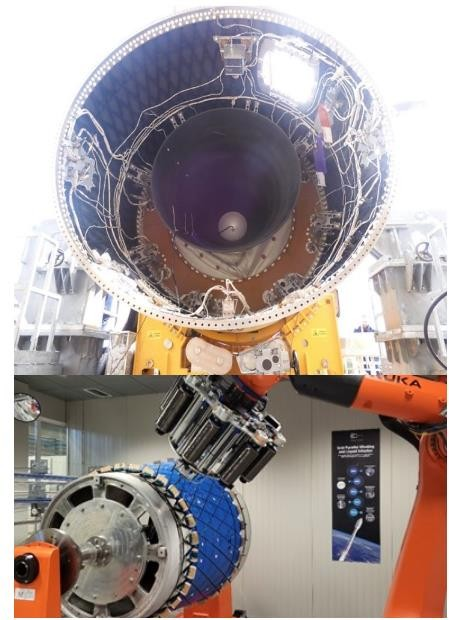
“We supported Avio in producing the Vega C interstage and worked with them to mature the process in our laboratory,” said De Nicola. “We developed the first prototypes together in our facilities. It took us two weeks to wind a 2.4-meter diameter, 2-meter-long Vega interstage prototype. After successfully completing tests in 2018, including compression loads up to 750 tons, Avio then produced certified parts.” Vega C made its first flight in 2022, but the mission was suspended after the second launch due to a failure in the Zefiro engine nozzle. Vega C is scheduled to resume flights in late 2024 with an intense launch schedule in 2025.”
The technology, known as “Grid parallel winding and liquid infusion” by CIRA, uses a robotic head to wind spiral dry fiber tows, while the creel simultaneously feeds tows for winding the ring ribs, so they are interwoven. Pins on the mandrel at the edge of the structure can form rings without cutting fibers. “We achieved perfect cross-sections in the laminates,” said De Nicola. “Because we use dry fibers instead of prepregs, there is no deformation and accumulation at the nodes.” These structures also have inherent damage resistance. “We were able to integrate optical fibers into the lattice, as we did in a 1.4-meter diameter, 7-kg conical adapter demonstrator. This was tested at 80 tons at Israel Aerospace Industries. For these dry fiber anisotropic grid preforms, we also integrated interwoven thermoset composite flanges, window frames, and local attachment points, then co-infused and cured the entire structure. We have successfully tested the load-bearing capacity of these local attachment bolts through the ribs.”
The UK-based Customised Materials Company (CMC)
High-Temperature Materials Systems (HTMS, Bristol, UK), established in 2021, exhibited in the exhibition’s start-up booster area, aiming to develop customized alumina matrix CMC materials that can withstand temperatures ranging from 300 to 1000°C. Products developed so far include:
– KappaCera: A new type of CMC material with a low dielectric constant even in high-temperature environments. This is the result of integrating advanced fibers into HTMS’s most advanced matrix system and optimizing the chemical composition within the entire system.
– CarboniteX: Incorporating high-strength carbon fibers into HTMS’s advanced matrix system, which significantly exceeds the current temperature capabilities of carbon fiber-based systems.
– PhantomWeave: A multi-functional CMC system designed to meet the complex requirements of the defense sector, combining low-observability characteristics with high-temperature durability.
– IgniShield: A low-density material made from basalt woven fibers with HTMS’s proprietary matrix, specifically designed for fire/smoke/toxicity applications in industries such as automotive, aerospace, and energy.
German SiC Fibers and CMC Components
BJS Ceramics and BJS Composites (Gersthofen, Germany) were established in 2014 and 2015 respectively. BJS produces its own SiC fibers using a proprietary process, branded as Silafil. It also uses Silafil preceramic polymers as matrix infiltration carbon and SiC fiber-reinforced materials to manufacture Keraman CMC materials and components.
“We have a pan-European supply chain,” said Jutta Schull, partner and co-founder. “We are selling CMC components into aerospace engine, space, and defense applications that require high strength, high-temperature resistance, and thermal shock resistance. We offer on-demand manufacturing services as well as prototype and small-batch production.”
BJS is developing a proprietary process for 3D printing CMC components using short-cut SiC or carbon fibers in a slurry. “We are studying short fibers and moving towards very long fibers,” said Schull. The company has also developed fibers for reinforced metal matrix composites (MMC) such as those used to reduce the weight of landing gear.
These companies are increasing their production capacity. Schull pointed out: “We are seeing an increase in demand from the aerospace and defense sectors, but also from the energy industry, including nuclear fission and fusion, as cooling pumps cannot fail.” “This also applies to pumps for water management under harsh conditions, such as desalination (salt) and emergency pumps (mud, silt). CMC provides extreme durability, ensuring the safety and continuous operation of critical infrastructure.” She cited the example of SiC/SiC pump bearing bushes that have been continuously produced for 25 years.
Regarding the potential of CMC components in nuclear energy, Jutta Schull noted, “CMC could be a game-changer. According to our customers’ findings, SiC/SiC components can double the power output of fusion reactors due to their heat resistance, high damage tolerance, and radiation resistance. These are, of course, long-term but very exciting development projects.”
Industrialization of inductive heating for composite material manufacturing
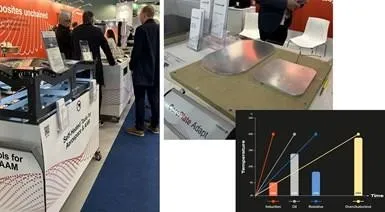
Corebon (Malmö, Sweden) has developed modular and adaptive inductive heating technology that can retrofit existing production equipment to increase production capacity. It enables very fast and uniform heating, eliminating long dwell times and reducing cycle time by 80%, thus saving 50-80% energy. The company demonstrated its heated plate products, inductive welding devices, and shell tool solutions, which may use the same power supply and control equipment. Its heated plate products include:
CorePlate integrated heating and cooling plates (500×500 mm) for integration into presses. Heat up to 275°C at 35°C/min and cool down at 120°C/min (3-4 times faster heating and cooling compared to traditional methods). Multiple adjacent plates can be used for large part geometries and multi-cavity tools.
CorePlate Adapt uses base inductive heating only where the mold is placed, up to 220°C and up to 50°C/min. Custom sizes, suitable for various printing machines. Load the plates into the press and place the mold on each plate. Cooling can be provided on request.
CorePlate Tailor is designed specifically for each geometry and is suitable for high-volume production, capable of heating up to 220°C at a rate of up to 100°C/min. Cooling can be provided on request. Its heating speed is three times faster than traditional composite material processing technology.

Unwind3D (Varese, Italy) is a subsidiary of ZSK (Krefeld, Germany), a supplier of industrial embroidery machines. Unwind3D works with customers worldwide to provide tailored solutions for the production of TPC parts that benefit from the use of tailored fiber placement (TFP) technology (realized by ZSK equipment).
The company demonstrated the Spidui forming cell using a nine-cavity steel tool with inductive heating, showing a fast compression molding cycle (<5 minutes) for TPC preforms with a PA6 matrix. Corebon inductive heating coils are located in each cavity of the top and bottom molds. Cooling is achieved through water or air. Integrated software enables user-friendly operation.
